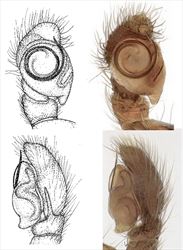
Aspects of the general morphology of Margaromma
Illustrators (and ©) B.J. Richardson (CSIRO), R. Whyte (M), M. Zabka (diag.)

Palp morphology of Margaromma
Illustrator (and ©) B.J. Richardson (CSIRO)

Epigyne morphology of Margaromma
Illustrators (and ©) R. Whyte (TL), B.J. Richardson (BL), M. Zabka (diag.)
Margaromma Keyserling, 1882
Taxonomy
Margaromma presently includes three Australian species: Margaromma funestum, M. obscurum and M. semirasum. It is likely the latter two species do not belong in this genus. Zhang and Maddison (2015) proposed M. semirasum be transferred to Omoedus.
Description
Margaromma funestum is a small spider with a body length of about 3 mm. In the female the head, viewed from above, is pear-shaped, widest behind the posterior lateral eyes. The abdomen is heart-shaped or rounded. The legs are short and solidly built. Leg four is longer than leg three. Chelicerae have a single retromarginal tooth (unident).
The male palps are as wide as long, with a proximal lobe. A large, two-coiled embolus lies on the upper (distal) surface of the tegulum. There is a well-developed, long, retro-lateral tibial apophysis.
Females have two epigynal atria with sclerotised guides. The lateral-facing, sclerotised copulatory openings are near the posterolateral edges. The insemination ducts are short and travel in a medial direction across the tops of the spermathecae, which are round and lie between the atria and the epigastric fold, very close to one another.
Biology
Margaromma funestum has almost always been captured in pitfall traps and presumably lives in litter.
Distribution
Margaromma is found in moderate to higher rainfall areas of New South Wales, and drier areas of South Australia and Western Australia. One of the (lost) types is from Cape York.
References
Davies, V.T. & Żabka, M. 1989. Illustrated keys to the genera of jumping spiders (Araneae: Salticidae) in Australia. Memoirs of the Queensland Museum 27, 189-266.
Richardson, B.J. & Żabka , M. 2016. Salticidae. Arachnida: Araneomorphae. Canberra, Australian Faunal Directory. Australian Biological Resources Study, at https://biodiversity.org.au/afd/taxa/SALTICIDAE.
Zhang, Junxia & Maddison, W.P. 2015. Genera of euophryine jumping spiders (Araneae: Salticidae), with a combined molecular-morphological phylogeny. Zootaxa 3938: 1-147.
* The information sheet should be interpreted in the context of the associated diagrams and photographs. Diagrams explaining anatomical terms can be found in the ‘Salticidae’ pictures at the beginning of the list of genera.